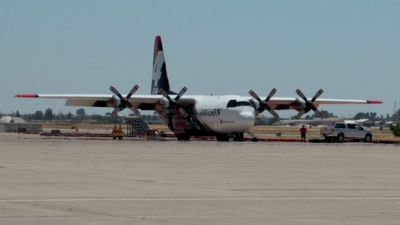
Victims were firefighters from Wyoming, Arizona and Florida
By Miriam Raftery
Photo courtesy of Gov. Gavin Newsom's office: C-130 that crashed in Australia today is same one shown in photo at McClellan Air Base during an event last August attended by Newsom.
January 23, 2020 (Ramona) – A plane used to fight California wildfires last year and to train Cal-Fire pilots has crashed while fighting brush fires in Australia, killing three U.S. firefighters. A C-130 was in Ramona last August to train future pilots.
The C-130 Hercules aircraft built by Lockheed Martin and repurposed to fight fires was operated by Coulson Aviation of Canada, which has grounded its fleet to re-assess safety conditions and honor the victims.
“Our heartfelt condolences go out to the family, friends and colleagues of the crew from Tanker 134 that wre lost during a tragic crash while battling the devastating Australia fires. Cal Fire stands with you during this difficult time,” Cal Fire Chief Thom Porter said.
Governor Gavin Newsom voiced condolences to families of the crew and Cal Fire for the loss of “three heroic American firefighters” He adds, “This tragic accident reminds us all of the too-high cost of the scourge of wildfires, as well as the sacrifice of first responders from around the world. California and Australia, already united by the deadly threat of wildfires, now grieve this tragic loss together.”
Last August, a county video showed C-130 pilot training at the Ramona airbase, on lease from the U.S. Forest Service. Cal Fire informed ECM at the time that the federal government planned to give Cal Fire seven C-130 aircraft no longer needed by the U.S. Air Force. Captain Issac Sanchez indicated that Cal Fire had plans to add fire retardant systems to its fleet with an ultimate goal of stationing one of the planes permanently in the San Diego area.
The C-130 has the capacity to drop up to 4,000 gallons of fire retardant, providing an important boost to Callifornia’s firefighting capabilities.
Tanker 134 crashed shortly after takeoff today in the Snowy Monaro area of New South Wales, Australia, during a firefighting mission while operating on contract with Australia’s Rural Fire Service. Australian authorities are investigating the cause of the crash.
Coulson Aviation has released a statement about the three US aerial firefighters killed in the Snowy Mountains crash.
Captain Ian McBeth, 45, from Great Falls in Montana, was a “highly qualified and respected C-130 pilot with many years fighting fire, both in the military and with Coulson Aviation”, the company said in a statement.
He served with the Wyoming Air National Guard and was a member of the Montana Air National Guard. He was a qualified instructor and evaluator pilot and spent his entire career flying C-130s. McBeth is survived by his wife Bowdie, three children Abigail, Calvin and Ella, parents William and Anneliese and three siblings.
First Officer Paul Clyde Hudson, 43, from Buckeye, Arizona, served in the US Marine Corps for 20 years, including as a C-130 pilot. He reached the rank of Lieutenant Colonel before retiring and working for Coulson Aviation. Hudson is survived by his wife Noreen.
Flight Engineer Rick A DeMorgan Jr, 44, from Navarre, Florida, served as a flight engineer on the C-130 in the US Air Force for 18 years. He had more than 4,000 hours as a flight engineer, including 2,000 in a combat environment. DeMorgan is survived by his children Lucas and Logan, parents Rick Sr and Linda, and his sister Virginia.
 As of last week, this season’s Australian bush fires are estimated to have burned over 46 million acres, or 72,000 square miles, destroying thousands of homes and other buildings. Prior to today’s tragedy, at least 33 people had died in the fires; scientists have estimated that as many as a billion animals have perished and some species may be driven to extinction.
As of last week, this season’s Australian bush fires are estimated to have burned over 46 million acres, or 72,000 square miles, destroying thousands of homes and other buildings. Prior to today’s tragedy, at least 33 people had died in the fires; scientists have estimated that as many as a billion animals have perished and some species may be driven to extinction.
The fires are Australia’s worst on record, many times larger than the brush fires that scorched much of California last year, fueled in part by climate change that has resulted in hotter, drier conditions.










Comments
Tragic
Brave souls. Search the web for videos of firefighting aircraft. Fire creates it's own local weather, pilots cannot see up or downdrafts. I saw smokejumpers while hiking in Anza Borrrego park, there was a fire nearby, me and Rob managed to get to the paved road.